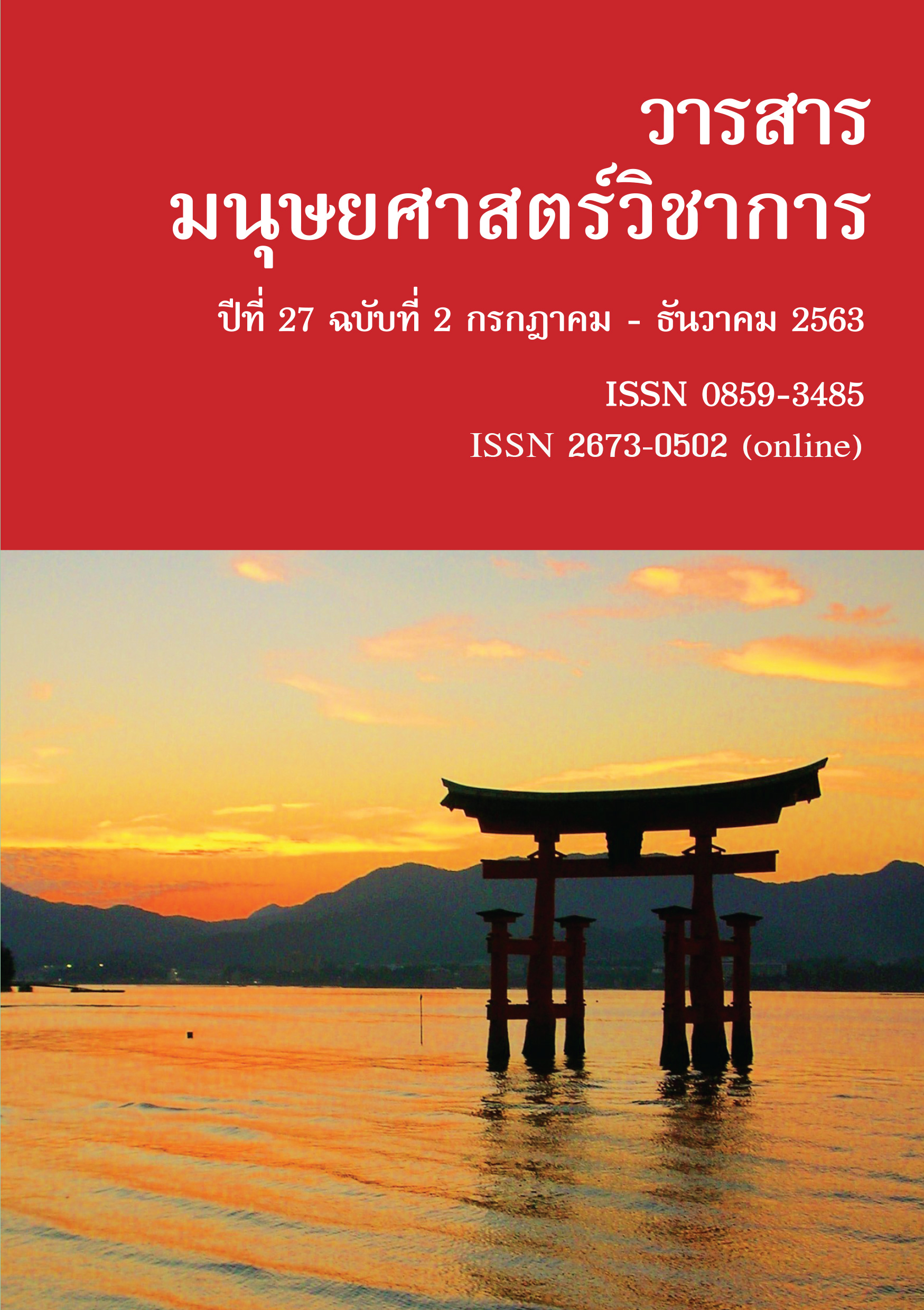การเลือกภาษาของป้ายสาธารณะในมหาวิทยาลัยของไทย กรณีศึกษาจากจุฬาลงกรณ์มหาวิทยาลัย และมหาวิทยาลัยเกษตรศาสตร์
Main Article Content
บทคัดย่อ
การสื่อสารในระดับโลกส่งผลให้บทบาทของภาษาอังกฤษในฐานะภาษานานาชาติเพิ่มขึ้นแม้กระทั่งในสังคมที่ภาษาไทยมีบทบาทสำคัญ เช่น กรุงเทพฯ ฮิบเนอร์ (2006) วิเคราะห์การเลือกภาษาบนป้ายสาธารณะที่ออกโดยหน่วยงานเอกชนและพบบทบาทที่เพิ่มขึ้นของภาษาอังกฤษในหลายพื้นที่ของกรุงเทพฯ โดยเฉพาะพื้นที่ที่มีชาวตะวันตกอาศัยอยู่มาก เช่นเดียวกับสิริเจริญ (2016) ที่ศึกษาภาวะหลายภาษาบนป้ายสาธารณะของคณะอักษรศาสตร์จุฬาลงกรณ์มหาวิทยาลัยและพบว่าภาวะสองภาษาไทยและอังกฤษมีบทบาทสำคัญในบริเวณคณะอักษรศาสตร์ การศึกษาทั้งสองชิ้นนี้แสดงให้เห็นถึงบทบาทที่สำคัญของภาษาไทยโดยมักปรากฏคู่กับภาษาอื่นๆ ที่มีบทบาทน้อยกว่า เช่น ภาษาอังกฤษและภาษาจีน อย่างไรก็ตาม จากการสังเกตพบว่าป้ายสาธารณะในมหาวิทยาลัยไทยบางแห่งมีรูปแบบที่แตกต่างจากรูปแบบที่พบในการศึกษาอื่นๆ ดังนั้นการศึกษานี้จึงมุ่งวิเคราะห์รูปแบบของการเลือกภาษาบนป้ายสาธารณะในมหาวิทยาลัยได้แก่ จุฬาลงกรณ์มหาวิทยาลัยซึ่งตั้งอยู่ในเขตใจกลางเมืองและมหาวิทยาลัยเกษตรศาสตร์ซึ่งตั้งอยู่บริเวณชานเมือง ผลการวิเคราะห์พบว่ารูปแบบของป้ายสาธารณะในมหาวิทยาลัยไทยมีรูปแบบเดียวกับป้ายสาธารณะในงานวิจัยอื่นๆ อย่างไรก็ตาม ผู้วิจัยพบรูปแบบของการเลือกภาษาที่แตกต่างออกไปจากผลของงานวิจัยอื่น 4 รูปแบบได้แก่ รูปแบบที่ 1. ใช้รูปแบบการเขียนแบบหนึ่งภาษาแต่ใช้ภาษาอังกฤษเท่านั้น รูปแบบที่ 2. ใช้รูปแบบการเขียนแบบพ้องความหมายแต่ใช้ภาษาอังกฤษเป็นหลัก รูปแบบที่ 3. ใช้รูปแบบการเขียนแบบปนภาษาในระดับนามวลีโดยใช้ไทยปนกับภาษาอังกฤษ รูปแบบที่ 4. ใช้รูปแบบการเขียนแบบพหุภาษาแบบอังกฤษ-ไทย ซึ่งสะท้อนให้เห็นบทบาทที่เพิ่มขึ้นของภาษาอังกฤษบนป้ายสาธารณะในมหาวิทยาลัยของไทย ดังเช่นที่สปอลสกี้ (2009) กล่าวไว้ว่าการเลือกภาษาบนป้ายสาธารณะสะท้อนนโยบายภาษาของมหาวิทยาลัย
Article Details
เอกสารอ้างอิง
Backhaus, P. (2007). Linguistic Landscape: A Comparative Study of Urban Multilingualism in Tokyo. Multilingual Matters: New York.
Ben-Rafael, E., Shohamy, E., Amara, M. H., & Trumper-Hecht, N. (2006). Linguistic Landscape as Symbolic Construction of the Public Space: The Case of Israel. International Journal of Multilingualism, 3(1), 7-30.
Coulmas, F. (2009). Linguistic landscaping and the seed of the public sphere. In E. Shohamy & D. Gorter (Eds.), Linguistic landscape: Expanding the scenery (pp. 13-24). New York. NY: Routledge.
Crystal, D., (2012). English as a global language. Cambridge University Press.
Draper, J. & Nilaiyaka, A. (2015) Culture and language promotion in Thailand: implications for the Thai Lao minority of introducing multilingual signage. Asian Ethnicity, 16(2) pp.203-234.
Fishman, J.A., (1972). Domains and the relationship between micro-and macro-sociolinguistics. Directions in sociolinguistics: The ethnography of communication, pp.435-453.
Giles, H. and Coupland, N., (1991). Language: Contexts and consequences. Thomson Brooks/Cole Publishing Co.
Holmes, J., (2013). An introduction to sociolinguistics. Routledge.
Huebner, T. (2006). Bangkok’s linguistic landscape: Environmental print, code-mixing and language change. in D. Go rter (ed.) Linguistic landscape: A new Approach to Multilingualism, pp.31- 51.
Jing-Jing, WANG., (2015). Linguistic Landscape on Cam pus in Japan-A Case Study of Signs in Kyushu University. Intercultural Communication Studies, 24(1).
Landry, R. and R. Y. Bourhis. (1997). Linguistic landscape and ethnolinguistic vitality: An Empirical Study. Journal of Language and Social Psychology 16.1: 23-49.
Mei, T.L., Abdullah, A.N., Heng, C.S. and Kasim, Z.B.M., (2016). Language Choice and Use of Malaysian Public University Lecturers in the Education Domain. Advances in Language and Literary Studies, 7(1), pp. 21-32.
Siricharoen, A. (2016). Multilingualism in the linguistic lands cape of the faculty of Arts, Chulalongkorn University, Thailand. MAUSYA: Journal of Humanities (22), pp.12-25.
Spolsky, B. (2009). Language Management. Prague: Cambridge University Press.
Spolsky, B. & Lambert, R. (2006). Language planning and policy: models. In Keith Brown (ed.), Encyclopedia of language and linguistics [2nd edition, Vol. 6], 561-575. Oxford: Elsevier.
Tabajunda, D. (2018). Linguistic Schoolscape as Public Communication: A Study of Announcements and Signages in De La Salle University - Dasmariñas. Proceedings of the 32nd Pacific Asia Conference on Language, Information and Computation. Association for Computation al Linguistics: Hong Kong.


